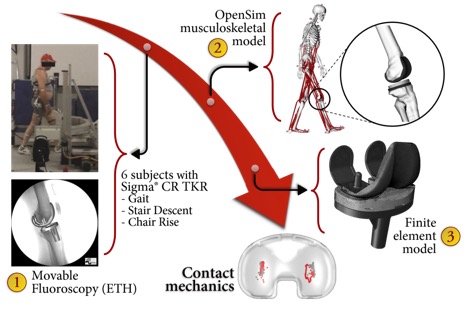Jan 24, 2017
Webinar: Musculoskeletal simulations combining multiscale data and finite element modeling of the knee
Learn about linking joint-level deformable finite element models with multibody musculoskeletal simulations
DID YOU MISS THIS EVENT?
A recording of the event is available for viewing. Visit https://simtk.org/projects/knee_model to find models mentioned in the webinar and to continue the discussion from the webinar Q&A session. To learn more about the work, check out the publications listed at the bottom of this page.Details
Title:Musculoskeletal simulations combining multiscale data and finite element modeling of the knee Speakers: Kevin Shelburne, Alessandro Navacchia, and Azhar Ali, University of Denver Time: Tuesday, January 24, 2017 at 10:00 a.m. Pacific Standard TimeAbstract
Musculoskeletal simulations of movement are traditionally performed using rigid multibody models with simplified joint representations that do not account for the deformability and complex motion of biological tissues and articulations. However, several pathological conditions and treatments, such as osteoarthritis and total joint replacement, can be best investigated within a deformable modeling framework. Local tissue deformation is usually modeled with the finite element method that discretizes an arbitrary geometry into a mesh of deformable elements. While finite element models have been widely used to describe the tissue behavior at the organ/joint level (e.g. bone, knee joint), the interaction between this local level and the neuromuscular behavior at the whole-body scale is often neglected. We will present a conceptual overview of multi-scale musculoskeletal modeling, and two examples of multi-scale approaches in a sequential fashion that link the outputs from a multibody OpenSim musculoskeletal simulation to joint-level deformable finite element models.
Webinar highlights:
- Conceptual overview of multi-scale musculoskeletal modeling.
- Presentation of two examples of the multi-scale sequential modeling approach that links multibody simulations to deformable finite element models.

Figure 1. Workflow of the multi-scale sequential modeling approach used to estimate deformable contact mechanics for total knee replacement patients performing activities of daily living.
Read more about this work
- A Navacchia, V Kefala, KB Shelburne (2016) "Dependence of muscle moment arms on in-vivo three-dimensional kinematics of the knee," Annals of Biomedical Engineering (in press).
- AA Ali, S Shalhoub, AJ Cyr, CK Fitzpatrick, LP Maletsky, PJ Rullkoetter, KB Shelburne (2016) "Validation of predicted patellofemoral mechanics in a finite element model of the healthy and cruciate-deficient knee,"Journal of Biomechanics, 49(2):302-9.
- A Navacchia, CA Myers, PJ Rullkoetter, KB Shelburne (2016) "Prediction of in vivo knee joint loads using a global probabilistic analysis," ASME Journal of Biomechanical Engineering, 138(3):4032379.
- MD Harris, AJ Cyr, AA Ali, CK Fitzpatrick, PJ Rullkoetter, LP Maletsky, KB Shelburne (2016) "A Combined Experimental and Computational Approach to Subject-Specific Analysis of Knee Joint Laxity," ASME Journal of Biomechanical Engineering (in press).
- A Navacchia, PJ Rullkoetter, P Schutz, R List, CK Fitzpatrick, KB Shelburne (2016) "Subject-specific multiscale modeling of muscle force and knee contact in total knee arthroplasty," Journal of Orthopaedic Research, 34(9):1576-87.
- Gaffney BM, Harris MD, Davidson BS, Stevens-Lapsley JE, Christiansen CL, Shelburne KB (2015) "Multi-joint compensatory effects of unilateral total knee arthroplasty during high-demand tasks," Annals of Biomedical Engineering, 44(8):2529-41.
- JC Ivester, AJ Cyr, MD Harris, MJ Kulis, PJ Rullkoetter, KB Shelburne (2015) "A Reconfigurable High-Speed Stereo-Radiography System for Sub-millimeter Measurement of In-vivo Joint Kinematics," ASME Journal of Medical Devices, 9(4): 041009.
